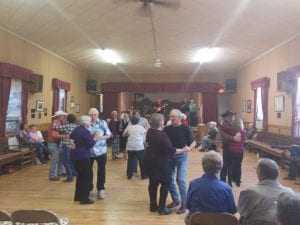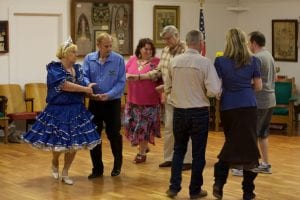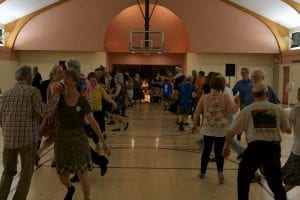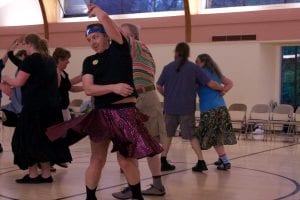Thomas Grant Richardson
In the Spring of 2018 I conducted ethnographic fieldwork in Benton and Linn Counties in the Willamette Valley. Folklorists focus on the everyday traditions of people in communities and at how people define creativity, tradition, and community in their own lives. It is therefore a great joy to work as a folklorist, to be invited into the creative spaces of people often quite different from myself, and to have conversations that usually include phrases like “this is the most important thing in the world to me.”
While in Benton and Linn Counties I encountered numerous wonderful and generous people connected to many vibrant traditions, including fly-fishing, boat building, instrument building, quilting, fiddle music, and various foodways. I was particularly struck by the area’s social dance traditions. During the three weeks I spent traversing the two counties, I attended three different social dances, although I could have attended one nearly every single night.

The Jefferson Jammers is mostly two-step, waltz, and line dancing, and happens every single Wednesday
The Jefferson Jammers perform on Wednesday nights at the Morning Star Grange Hall in Millersburg. This dance started as a country music jam among retired musicians who still wanted to play. Bruce and Joann Hamilton held the first few jams in their home, but it quickly outgrew their capacity, and they moved to the Grange Hall. Today it serves as a place for musicians to gather to play country music together; anyone interested can also sing along in a kind of live-backed karaoke. The audience is busy dancing with the floor usually occupied by at least 30-40 dancers. Mostly attended by local residents above the age of 50, the dance also brings in younger participants. Most attendees told me it’s the highlight of their week.

The Albany Timber Twirlers Modern Western Square Dance club’s membership is diminishing in number but not in dedication.
In nearby Albany, the Albany Timber Twirlers are a Modern Western Swing Dance Club (one of four clubs in the area) that focus on the highly precise and intricate moves of choreographed square dances. These patterns are so complicated that dancers need to take four months of lessons before they’re up to speed to participate. Club President, Bev Swearengen, told me they’re more about fun than formality.

The Corvallis Contradance was by far the biggest dance I attended, with a regular attendance of around 100 people, twice a month.
In Corvallis, a twice-monthly Contra dance has a regular attendance of over 100 people. Contra dance is somewhere in between the loose nature of traditional square dancing and the highly stylized patterns of Modern Western Square Dancing; like traditional square dancing, it’s led by a caller who gives instructions in a rhythmic and stylized fashion. But contra dancers form lines with each member of a couple opposite each other instead of side by side like square dancers. The Corvallis Contra dance also includes a live band and brings in a huge number of dancers under 40. Dance Chair, Jennifer Carlin, notes that it’s the music that makes this dance so special.
But greater numbers do not always equal a more successful event or a more important folk tradition. Social dance is alive and well in this area. And next time someone in the central Willamette Valley suggests the Internet, television, or whatever latest scapegoat is killing social life, drive them to Benton and Linn County and find a dance!

